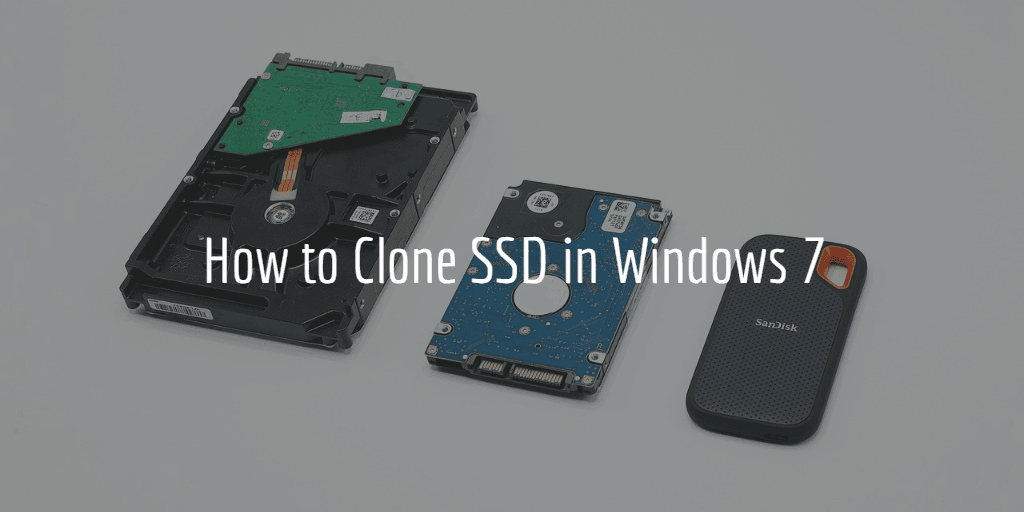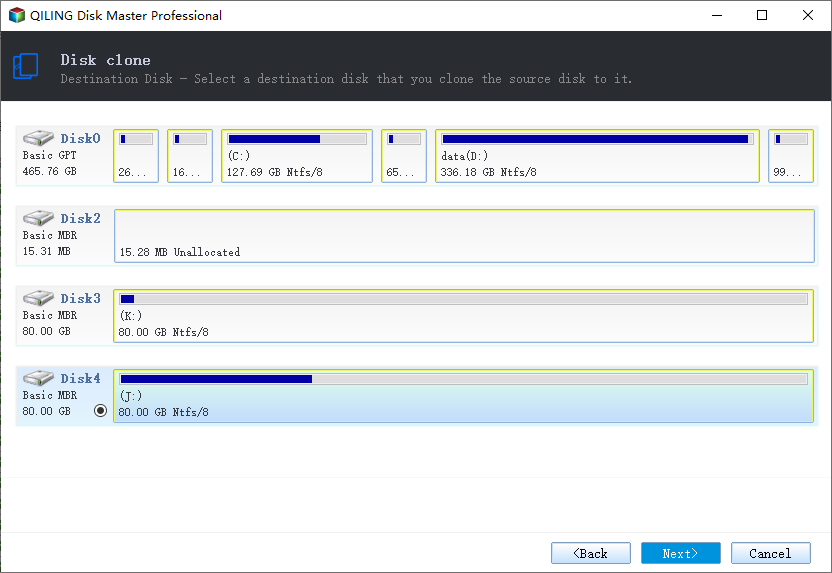How to Clone SSD in Windows 7 Easily Without Losing Data
Quick Navigation:
- Why do you clone SSD in Windows 7?
- Can you clone SSD to another hard drive in Windows 7?
- Preparations before cloning SSD to another SSD
- How to clone SSD in Windows 7 without data loss
- Summary
Why do you clone SSD in Windows 7?
You likely chose an SSD over an HDD for its speed and durability, but be aware that it's generally more expensive and has less capacity than an HDD for the same budget.
When you run out of space on your SSD in Windows 7/8/10, you can upgrade to a larger one, just like switching from an HDD to an SSD for better performance. However, if you don't want to lose your accumulated data, you'll need to use a reliable SSD cloning solution to copy everything to the new drive.
You didn't specify a topic. Please tell me what you'd like to talk about, and I'll do my best to assist you.
- How to clone SSD to another SSD in Windows 7
- How to clone HDD to SSD in Windows 7
- How to clone only Windows 7 to SSD
Can you clone SSD to another hard drive directly?
Migrating an SSD to a larger one without a transit device like USB or external hard drive can be a hassle. Manual copy and paste is not a safe and quick solution, as it doesn't account for hidden files and system files, and transmission speed is relatively low.
A reliable cloning tool is crucial in this situation, capable of cloning an SSD in Windows 7, 8, and 10. The process should be straightforward and easy to master for amateur users, with a range of customization options available to ensure a smooth and satisfactory migration.
Based on these considerations, I recommend Qiling Disk Master Professional, which supports all Windows OS and has powerful backup and cloning ability.
With EaseUS Todo PCTrans, you can easily perform disk migration, such as cloning a larger SSD to a smaller SSD, or cloning a smaller SSD to a larger SSD, in Windows 7.
Preparations before cloning SSD to another SSD
To perform SSD cloning in Windows 7, you need to prepare a larger SSD to clone to, ensure the target SSD is properly connected and recognized by the system, and have a reliable cloning software such as Acronis True Image or EaseUS Todo Backup. The source SSD should be properly shut down or disconnected to prevent data corruption during the cloning process. Additionally, it's recommended to back up any important data from the source SSD to an external drive or cloud storage before starting the cloning process.
- A target SSD to receive the cloned data
- If you have a laptop with only one drive bay, you can connect the second SSD as an external drive using a SATA-to-USB adapter. If your PC has multiple drive bays, you can install the new SSD without additional connection devices.
- Pick an easy-to-use SSD cloning software and download it
How to clone SSD in Windows 7 without data loss
You can quickly clone a SSD in Windows 7, Windows 8, Windows 10, etc. using the Disk Clone feature of Qiling Disk Master Professional.
★ The cloning process will copy all content from the current boot drive, including the system reserved partition if the boot disk was initialized as master boot record (MBR). However, if the SSD was partitioned before installing Windows 7, the system reserved partition will not be generated.
★ If your SSD is formatted with GUID partition table (GPT), it will include an EFI system partition, MSR partition, Windows recovery partition, and system partition, which requires UEFI hardware support as a boot drive.
★ If your computer is HP, Dell, or Lenovo, there is likely a factory recovery partition that allows you to restore it to its default settings. This partition, often labeled as OEM, can be included in a disk clone, making it possible to reset the computer to its factory settings on the cloned SSD.
★ With the default intelligent mode, you can clone a larger drive to a smaller drive, such as cloning a larger HDD to a smaller SSD, as it only copies used sectors to the target disk.
★ If you only want to clone Windows 7 to an SSD without changing other partitions on the old HDD or SSD, you can use the System Clone feature, which allows you to migrate only the OS to the SSD directly, leaving other files unrelated to the system unchanged.
Here's an example of cloning a smaller SSD to a larger SSD in Windows 7: you can use the built-in Windows tool, Disk Management, to clone the smaller SSD to the larger one, or use third-party software like Acronis True Image or EaseUS Todo Backup to achieve this. The process involves selecting the source disk (the smaller SSD) and the target disk (the larger SSD), and then initiating the cloning process. This approach can also be used to clone a HDD to an SSD or an SSD to a HDD, just by specifying the source and target disks accordingly.
How to clone SSD to another SSD in Windows 7:
Steps:
1. Launch Qiling Disk Master, select the Tools and utilities tab page, and choose Disk Clone.
2. Select your current SSD (the disk you wish to clone) as the source, click Next. Then select the new SSD (the disk you wish to clone to) as the destination, click Next.
3. To clone the source disk to a destination SSD, select the destination SSD from the available options and click "Next" to proceed. This will initiate the cloning process, allowing you to transfer the contents of the source disk to the destination SSD.
4. To optimize the cloning process, select the appropriate option from the menu: Edit Partition, SSD Alignment (recommended for improved performance), or Sector by Sector Clone. Review your choices, then confirm and click Proceed if everything looks correct.
◆ SSD Alignment: If your destination disk is a SSD, it's highly recommended to enable this option to accelerate reading and writing speed for solid state drives.
◆ Sector by Sector Clone: The command will clone all sectors, regardless of whether they're used or not, by ticking the box. Otherwise, it will only copy used sectors, being more intelligent in the process.
◆ Edit Partition: To clone a smaller SSD to a larger one, you can use software like EaseUS Todo Backup or Acronis True Image. These programs allow you to adjust the partition size and drive letter of the destination drive, ensuring a smooth cloning process. This is particularly useful when upgrading from a smaller SSD to a larger one, as it enables you to maximize the available storage space and maintain the original drive letter.
5. Wait for the cloning to end, then click the Finish button to exit.
To switch to the larger SSD, restart your PC, enter the BIOS settings using a specific key, set the cloned drive as the first boot option, save the settings, and exit. This will allow you to boot into Windows 7 with the larger SSD.
Tips:
- The Professional edition supports cloning both data disks and systems disks from MBR to MBR/MBR to GPT, or GPT to GPT/GPT to MBR. If you only want to clone data disks, you can choose the free Standard edition.
- Be sure to back up any important data on the destination SSD, as it will be completely overwritten during the cloning process. The original drive, on the other hand, will remain intact and can be formatted or used as a secondary storage device.
Summary
Qiling Disk Master allows cloning of a larger SSD to a smaller one in Windows, preserving data, and also enables cloning from a smaller SSD to a larger one, making it a versatile tool for SSD management.
Qiling Disk Master is a backup and restore software that allows you to back up files, folders, partitions, disks, and the system, even after disk migration, to prevent data loss and system failures. It also enables scheduled automatic backups to regularly protect important data.
Related Articles
- Top 2 Ways to Migrate Windows 7 from HDD to SSD Without Reinstalling
You will learn how to migrate Windows 7 from HDD to SSD with built-in Backup and Restore or Qiling Disk Master Professional. It will greatly enhance your computer without reinstalling Windows. - How to Clone NVMe to NVMe SSD in Windows (2 Ways)?
You got two easy ways to clone NVMe SSD to NVMe SSD successfully in different situations, including cloning via only one slot. - Best Freeware to Clone SSD to New SSD in Windows 10/8/7
The best way to clone SSD to new SSD with larger capacity is using specialized cloning software which helps you clone the entire SSD (Solid State Drive) to your new SSD with the intact stuff. - (Easiest Way) How to Clone 2.5 SSD to M.2 with Best SSD Cloning Software
Do you know how to clone 2.5 SSD to M.2? If you don't, you are coming to the right page. This article will tell you the difference between a 2.5 SSD and M.2 SSD and offer a solution for cloning an M.2 SSD from the 2.5 SSD. After reading this article, cloning 2.5 SSD to M.2 SSD will be a breeze.




